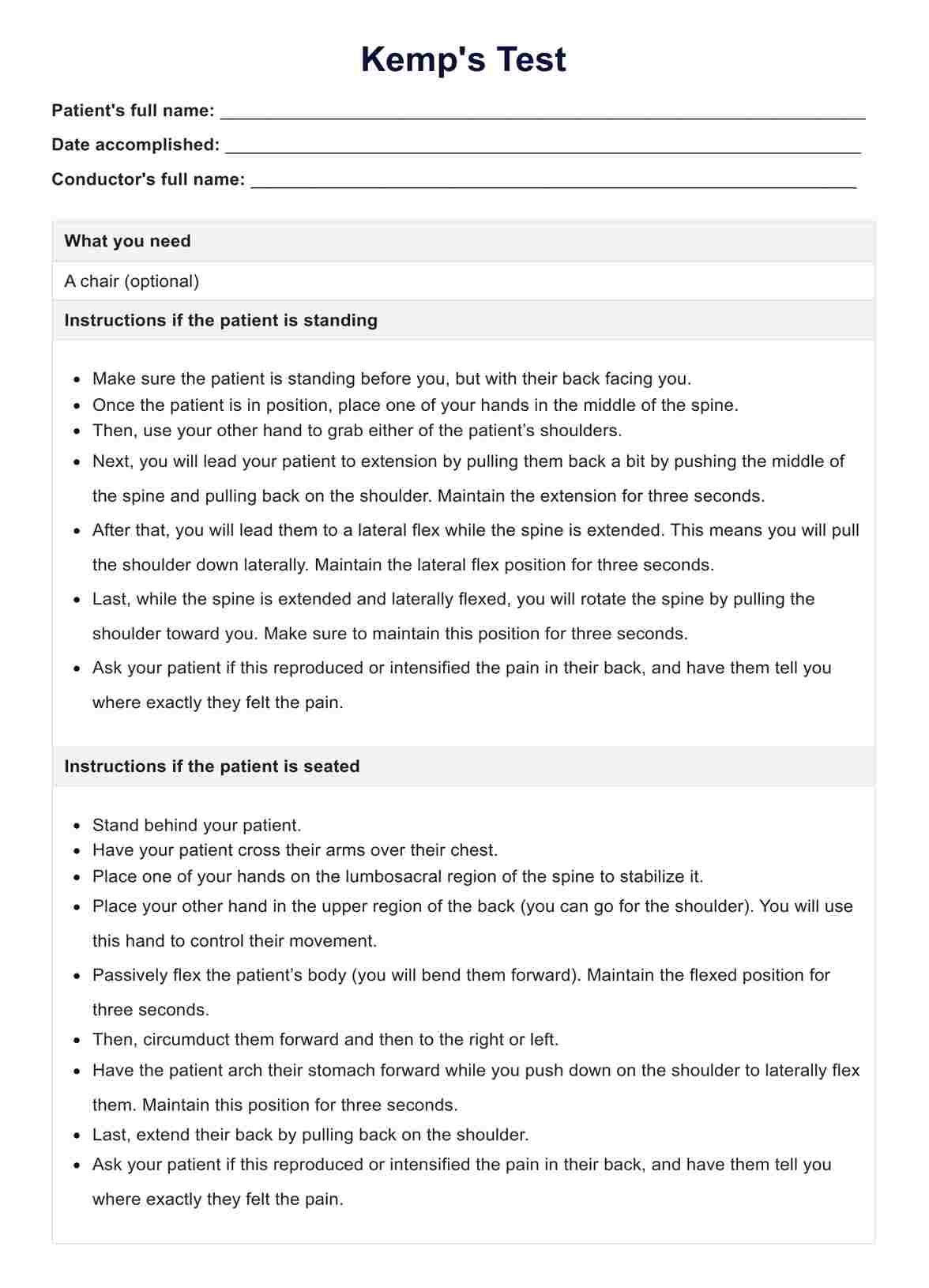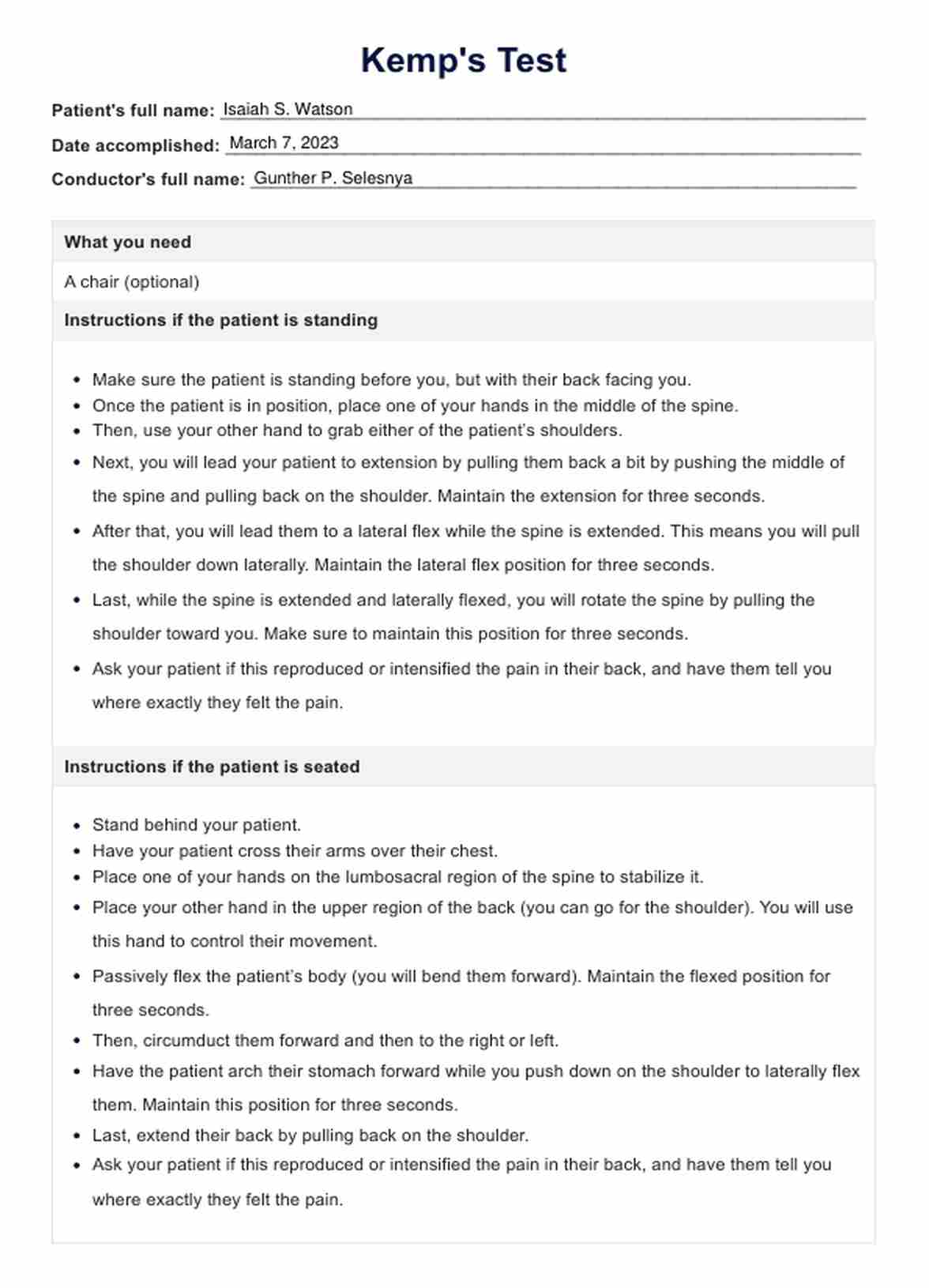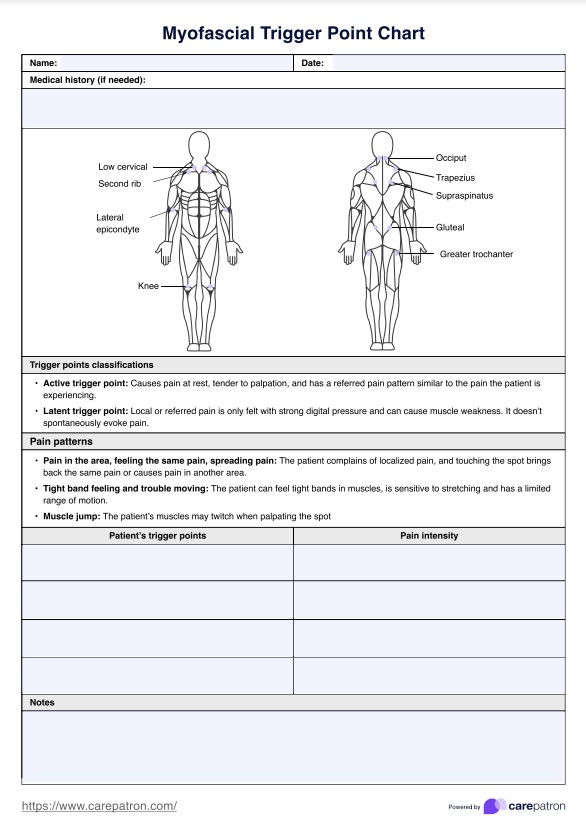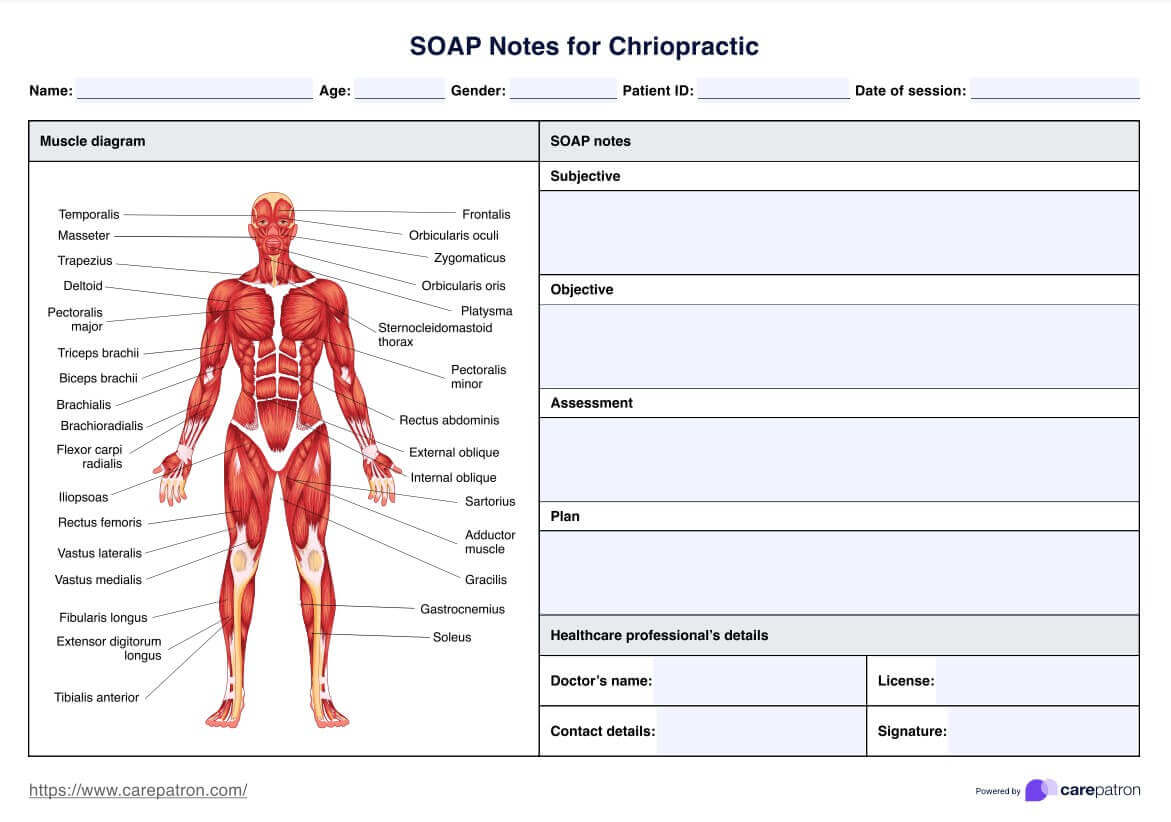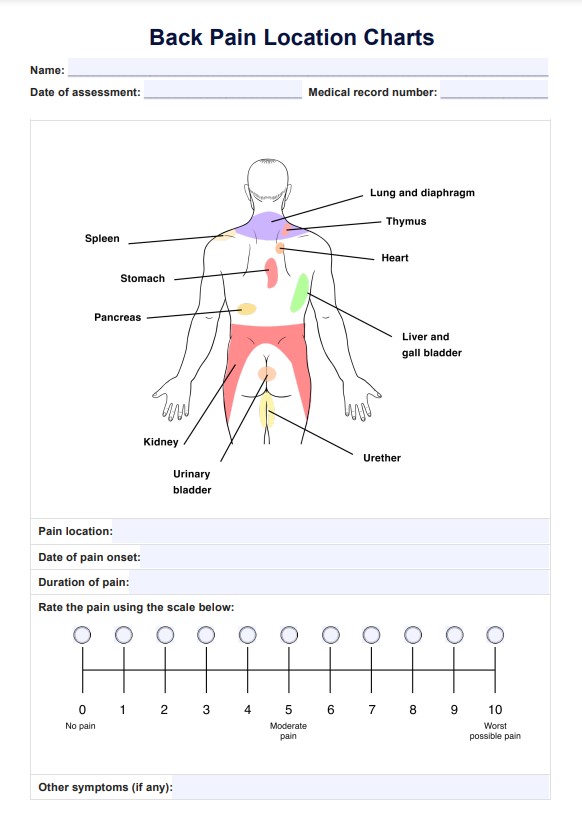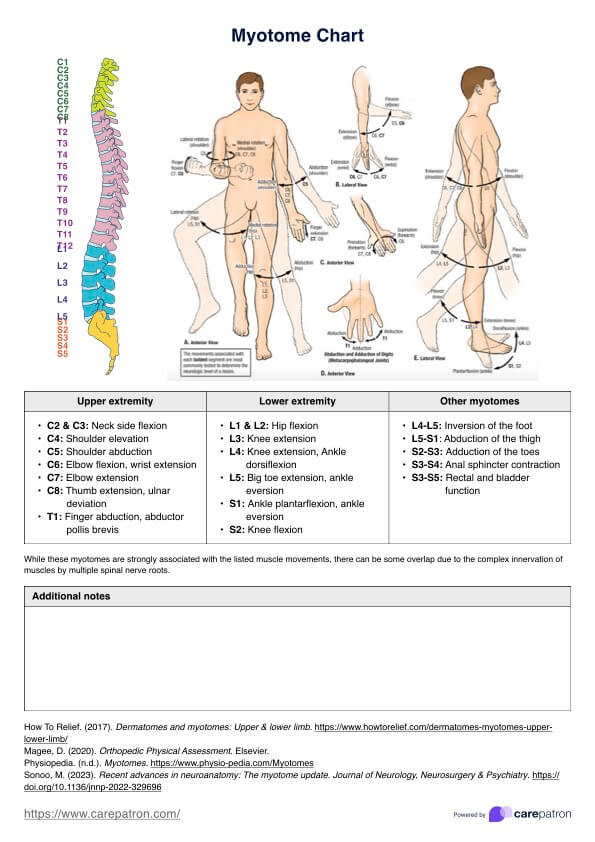Kemp’s Test
Learn how Kemp's Test can assess spine, leg, and back concerns through this guide.


What is the Kemp's Test?
Kemp's Test (known as Kemp's Sign) is an orthopedic test often performed on patients complaining about back pain. This technique is a provocation test, which means it will attempt to elicit the same pain that the patient feels so that professionals can locate where the pain is coming from and determine if it's a type of pain in one location (localized pain) or if it spreads out (radiating pain). It focuses on the cervical spine and lumbar spine, as well as relevant spine and extension rotations.
The Kemp test is usually conducted by a physical therapist, pain physician, orthopedist, and the like to assess the facet joints, which are the small joints between each of the spine's vertebrae. It helps diagnose facet joint pathologies like osteoarthritis, rheumatoid arthritis, and lumbar radiculopathy.
Common symptoms that may warrant using Kemp's Test include pain in the leg, back, buttocks, and thighs and weakened feelings in these areas. These can also make exercise, walking, and standing difficult.
Kemp’s Test Template
Kemp’s Test Example
How to perform the Kemp's Test
There are two ways to perform the Kemp's Test: standing or sitting. Whether you do so while they are standing or seated is entirely up to you, though it is best to consider what is more comfortable for your patient. If you opt for the seated method, just ensure the patient has a comfy chair.
If the patient is standing, do the following steps
- Make sure the patient stands before you but with their back facing you.
- Once the patient is in position, place one of your hands in the middle of the spine.
- Then, use your other hand to grab either patient's shoulders.
- Next, you will lead your patient to extension by pulling them back by pushing the middle of the spine and pulling back on the shoulder. Maintain the extension for three seconds.
- After that, you will lead them to a lateral flexion while the spine is extended. This means you will pull the shoulder down laterally. Maintain the lateral flex position for three seconds.
- Last, while the spine is extended and laterally flexed, you will rotate the spine by pulling the shoulder toward you. Make sure to maintain this position for three seconds.
- Ask your patient if this reproduced or intensified the pain in their back, and have them tell you where exactly they felt the pain.
If the patient is seated, then follow these instructions
- Stand behind your patient.
- Have your patient cross their arms over their chest.
- Place one of your hands on the lumbosacral region of the spine to stabilize it.
- The other hand will be placed in the upper region of the back (you can go for the shoulder). You will use this hand to control their movement.
- Passively flex the patient's body (you will bend them forward). Maintain the flexed position for three seconds.
- Then, circumduct them forward and then to the right or left.
- Have the patient arch their stomach forward while you push down on the shoulder to laterally flex them. Maintain this position for three seconds.
- Last, extend their back by pulling back on the shoulder.
- Ask your patient if this reproduced or intensified the pain in their back, and have them tell you where exactly they felt the pain.
Interpreting findings
Since Kemp's Test is a physical examination technique and a provocative test, it has no scores to calculate. All you need to do is ask the patient if they felt any pain, whether it's the same pain or an exacerbated level, while performing the test.
If they felt any pain while you flexed and extended their back, ask them if the pain was in a specific location and to pinpoint where. If it was, it was localized and indicative of facet joint pathology. This also means this is a positive test.
If they are positive for this test, the next step is to endorse them for further examination to confirm the specific facet joint pathology and/or other back conditions they might be dealing with.
If they felt pain while you flexed and extended their back, but they describe the pain to be radiating from one spot to multiple areas, especially if it reaches the lower extremities, they are negative for this test, but they are likely to be positive for other tests that are specifically for assessing patients for nerve root-related back problems. If this is the case, you must still endorse them for further examination.
They are also negative if they feel no pain at all.
When is the best time to conduct Kemp's Test?
The Kemp's Test is usually conducted whenever a patient reports pain in the back during an appointment. If they detail their symptoms and you suspect that the back pain is caused by facet joint pathologies or dysfunction, then it is appropriate that you conduct this test to gauge the pain. If the patient is actively experiencing pain and discomfort before you even start the test, that's even more reason to conduct it.
Do note that Kemp's Test should not be the sole test you conduct to make a proper diagnosis. Yes, the test has positive and negative designations, but they are not the equivalent of making an official diagnosis. This is because Kemp's Test only gauges the possibility of facet joint pathologies being the cause of the pain. It doesn't determine what specific pathology the patient is dealing with.
If you decide Kemp's Test is appropriate for your patient, include it in a comprehensive examination. This comprehensive examination should include other physical examination techniques as part of the diagnostic procedure, plus imaging tests, so that suspicions revolving around facet joint pain and pathologies can be confirmed or refuted. Other tests should also detect and confirm other problems that the patient is dealing with but is not aware of. The combined results will serve to make a well-informed official diagnosis.
What are the benefits of the Kemp's Test?
It can help pinpoint the specific location of back pain
One of the best things about Kemp's Test is that it can help healthcare professionals locate the source of the back pain and determine if the pain is localized, meaning it's just in a specific location or if it radiates. By reproducing back pain through Kemp's Test, professionals can narrow down the potential sources of pain and even determine which parts of the spine are involved, like facet joints.
It can determine what the possible problem is
Speaking of determining the potential sources of back pain, Kemp's Test can be used as grounding to determine what tests are necessary for the patient. If the pain is localized, then the problem is likely to have something to do with their facet joints, which means that other tests should support this result and determine the specific facet joint pathologies that the patient is dealing with.
If the test reproduces the pain, but the patient describes it as something that radiates to other parts of their back and lower extremities, then that's a sign of nerve root impingement or irritation. If that's the case, the next tests should be in favor of determining the cause of the nerve root irritation or damage.
This will also lay the foundation for treatment plans.
It can help educate and monitor patients
After performing the Kemp's Test on their patients, healthcare professionals can take the time to educate the patient about their potential conditions and what specific movements will exacerbate their pain. Patients will be informed about how they can manage their pain in the meantime and what to do depending on their diagnosis.
Once an official diagnosis has been made and a treatment plan has been implemented, the Kemp's Test can be used to monitor the patient's progress through routine check-ups. If the patient is feeling less pain or no longer feels pain at all when you perform the test, then they are getting better, and the treatment plan seems to be effective.
If they still feel the same level of pain or it somehow worsened over time, then perhaps making adjustments to your plan or overhauling it might do the trick. If surgery wasn't on the table before, then maybe think if performing surgery is the best choice if they're not getting better.
Commonly asked questions
The Kemp's Test can take 1 to 5 minutes due to the simple instructions.
Yes. It is painful in the sense that it seeks to reproduce the pain that patients are feeling. The pain is a requirement because it'll help professionals make a designation and determine if the problem has something to do with facet joints or some other part of the spine. Whatever pain the patient feels will be caused by a pre-existing condition. However, it should never cause extensive pain.
Yes. It helps professionals determine the possible problem. While it may not identify the specific problem, the test results will serve as groundwork to determine what other tests need to be conducted for diagnosing pain-related pathologies in the spine, leg, or back.


